Mastering Kitchen Hardware Placement: A Comprehensive Guide to Installing Knobs and Handles on Cabinets
The kitchen often stands as the beating heart of any home, a vibrant space where culinary creativity flourishes, families gather, and memories are made. Far more than just a room for cooking, it’s a central hub for daily life. To keep this essential space organized and efficient, kitchen cabinets play an indispensable role. They serve as the primary storage solution for a myriad of items, from delicious eatables and essential cooking utensils to elegant crockery and fresh raw ingredients. Without well-designed and functional cabinets, a kitchen would quickly descend into disarray, making everyday tasks cumbersome.
However, cabinets alone don’t complete the picture of a truly functional and aesthetically pleasing kitchen. Equally vital, yet often overlooked, is the cabinet hardware that adorns them. Knobs and handles are not merely decorative elements; they are crucial functional components that facilitate the opening and closing of cabinet doors and drawers. Beyond their practical utility, these small details significantly contribute to the overall design narrative and visual appeal of your kitchen’s interior.
Why Cabinet Hardware Matters: Beyond Just Opening Doors
Just as cabinets form the backbone of your kitchen’s storage, knobs and handles are the essential touchpoints that define how you interact with this storage. They are the means by which you access everything within your cabinets and drawers, making their design and placement critically important. Today, the market offers an astonishing array of design options for both knobs and handles, allowing homeowners to personalize their kitchen space to a remarkable degree. From sleek, modern lines to intricate, traditional motifs, the choices are vast. Yet, while attractive designs are appealing, the true brilliance of kitchen hardware lies not just in its look, but in its strategic placement, ensuring optimal functionality and ergonomic comfort.
Knobs vs. Handles: Choosing the Right Hardware for Your Kitchen
While both knobs and handles serve the fundamental purpose of opening cabinet doors and drawers, they possess distinct characteristics that influence both their aesthetic impact and functional performance. Understanding these differences is key to making an informed decision for your kitchen.
Knobs: Classic Charm and Compact Functionality
Knobs are typically small, single-point attachment pieces, often circular, square, or oval in shape. Their compact design makes them an ideal choice for smaller cabinet doors and lighter drawers. When installed, they offer a subtle, graceful touch to kitchen cabinetry, capable of complementing a wide range of kitchen styles, from quaint farmhouse to minimalist modern. Knobs are generally simpler to install, requiring only one screw hole.
Handles (Pulls): Modern Ergonomics and Design Versatility
Handles, also commonly referred to as pulls, are characterized by their longer, wider form factor and require two attachment points. This design inherently offers a more substantial grip compared to knobs, making them particularly advantageous for heavier drawers and larger cabinet doors. Handles often lend a more contemporary or industrial feel to a kitchen, though traditional and transitional styles are also widely available. Their robust design also tends to offer greater durability, as the force applied is distributed over a larger area. Handles are incredibly versatile and can be used on both small and large cabinets and drawers, providing a comfortable and secure holding mechanism for easy access.

Amazon Product Box Placeholder
Amazon Product Box Placeholder
Elevating Your Kitchen’s Style: Design and Material Choices for Knobs and Handles
The aesthetic impact of cabinet hardware cannot be overstated. Knobs and handles are like the jewelry of your kitchen, capable of defining its character and complementing its overarching design theme. Whether you’re aiming for a sleek, ultra-modern look or a cozy, rustic charm, there’s a design variation to match your vision.
Popular Materials and Finishes
The choice of material and finish is paramount. Options range widely, from the timeless elegance of stainless steel and brushed nickel to the warmth of wood, the versatility of plastic, and the delicate beauty of glass. Beyond these, you’ll find options like bronze, brass, ceramic, and even leather, each offering a unique tactile and visual experience. Finishes can vary from polished and satin to matte and antique, allowing for fine-tuning the look to perfection. Surprisingly, customized knobs and handles are also increasingly popular, providing a truly unique and personalized touch that sets a kitchen apart.
Matching Hardware to Kitchen Aesthetics
Consider the existing elements of your kitchen: appliance finishes, faucet styles, countertop patterns, and cabinet colors. Your hardware should either blend seamlessly or provide a thoughtful contrast that enhances the overall design. For instance, polished chrome or brushed nickel often pairs well with modern, minimalist kitchens, while oil-rubbed bronze or distressed brass can beautifully complement traditional or farmhouse styles. The size and scale of the hardware are also crucial; oversized handles can make a bold statement, while smaller knobs offer a more understated elegance. If the knobs and handles aren’t appropriately sized for the cabinet and the hand, they become impractical showpieces rather than functional tools.
The Critical Role of Proper Placement: Where to Put Knobs and Handles
Selecting the perfect hardware is only half the battle; knowing where to place knobs and handles on kitchen cabinets is equally, if not more, important. Correct placement ensures both optimal functionality and a visually appealing kitchen. Incorrectly placed hardware can disrupt the flow of your kitchen, making it less comfortable to use and visually jarring.
1. Achieving Visual Harmony and Symmetry
Thoughtful placement of knobs and handles contributes significantly to the visual balance and symmetry of your kitchen. Random or inconsistent placement can make the space feel chaotic and unfinished. When hardware is aligned uniformly across all cabinets and drawers, it creates a sense of order, sophistication, and a professional, custom-designed look. This symmetry elevates the overall attractiveness of the kitchen, demonstrating attention to detail and a commitment to aesthetic excellence.
2. Enhancing Accessibility for All Users
Ergonomics play a crucial role in kitchen design. Hardware should be positioned to be easily accessible for everyone who uses the kitchen, minimizing strain and maximizing convenience. For upper cabinets, knobs and handles should be placed at a height that allows comfortable opening without the need for a stool or excessive stretching. Conversely, for lower cabinets and drawers, placement should prevent unnecessary bending or awkward movements. Strategic placement ensures a seamless and comfortable user experience for all family members, regardless of height or mobility.
3. Maximizing Ease of Use and Durability
The primary function of cabinet hardware is to facilitate easy opening and closing. If knobs and handles are placed too high, too low, or too close to hinges, they can hinder smooth operation, making cabinets feel stiff or awkward to use. Proper positioning ensures a natural grip and leverage, making access effortless and reducing wear and tear on both the hardware and the cabinet itself. Taking the time to determine the best location before installation will save you frustration and potential damage in the long run, ensuring your hardware serves its purpose effectively for years to come.
A Step-by-Step Guide to Installing Kitchen Cabinet Knobs and Handles
Once you’ve carefully selected the ideal hardware for your kitchen, the next crucial step is precise installation. While seemingly straightforward, accurate placement is key to both functionality and aesthetics. Installing knobs and handles is a manageable DIY project that can be accomplished in a few steps with careful attention to detail.
Essential Tools You’ll Need
- Measuring tape or ruler
- Pencil (or painter’s tape for marking to avoid permanent marks)
- Drill (with appropriate drill bits for your hardware screws)
- Cabinet hardware template (highly recommended for consistency)
- Level (for handles)
- Screwdriver (manual or electric)
- Safety glasses
1. Accurate Measurements are Key
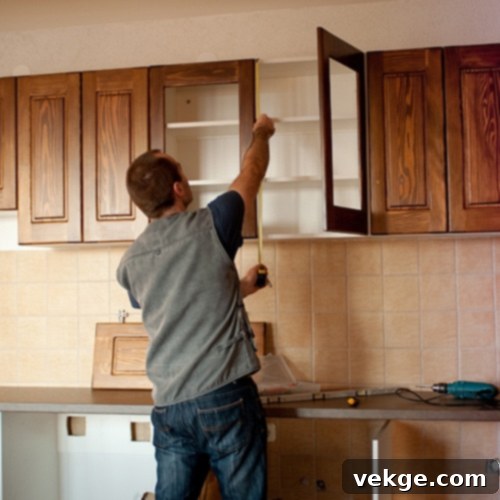
The foundational step for any hardware installation is to accurately measure your cabinet doors and drawer fronts. This precision will guide the placement and ensure uniformity across all your cabinetry. Use a reliable measuring tape, checking it for any discrepancies before starting. For drawers that are 24 inches or less in width, a single knob or pull is typically sufficient. For wider drawers, those exceeding 24 inches, two knobs or pulls are generally recommended to provide balanced access and visual appeal.
Amazon Product Box Placeholder
2. Marking the Exact Location for Knobs
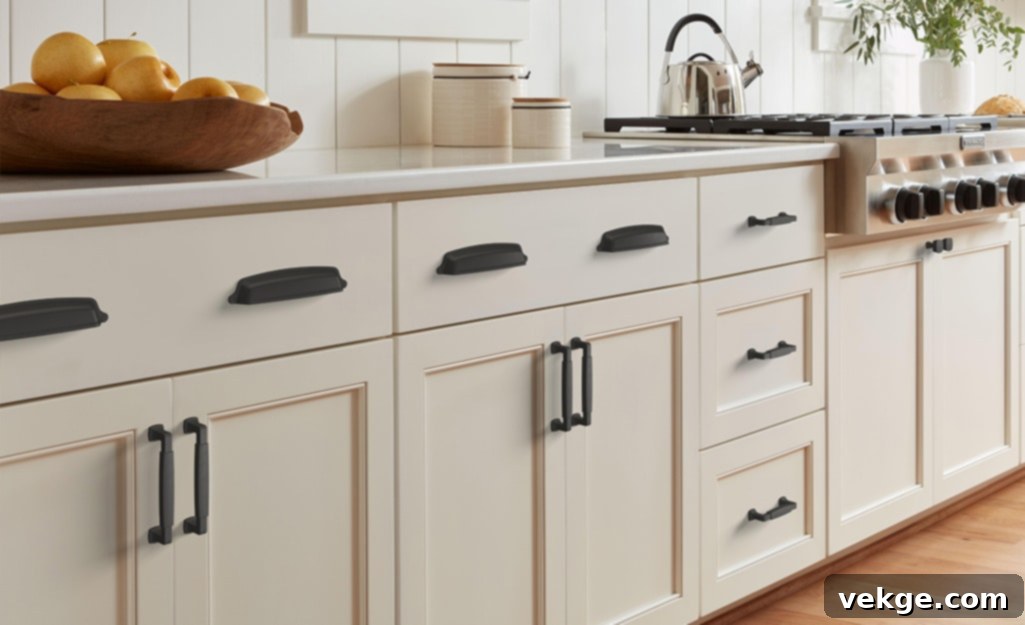
To determine the precise placement for a knob on a drawer, a helpful method is to mentally (or physically, using painter’s tape) divide the drawer front into a grid of three equal rows and three equal columns. For a single knob, the ideal placement is exactly in the center of the middle square (second row, second column). If you’re opting for two knobs on a wider drawer, place the first knob in the center of the first column of the second row, and the second knob in the center of the third column of the same row. Using painter’s tape to mark these divisions and the exact drilling points can protect your cabinet surfaces from pencil or marker marks. Once your marks are precise, you can remove the tape. Remember, the installation method differs slightly between cabinet doors and drawers.
Amazon Product Box Placeholder
3. Installation Guide for Base Cabinet Doors (Knobs)
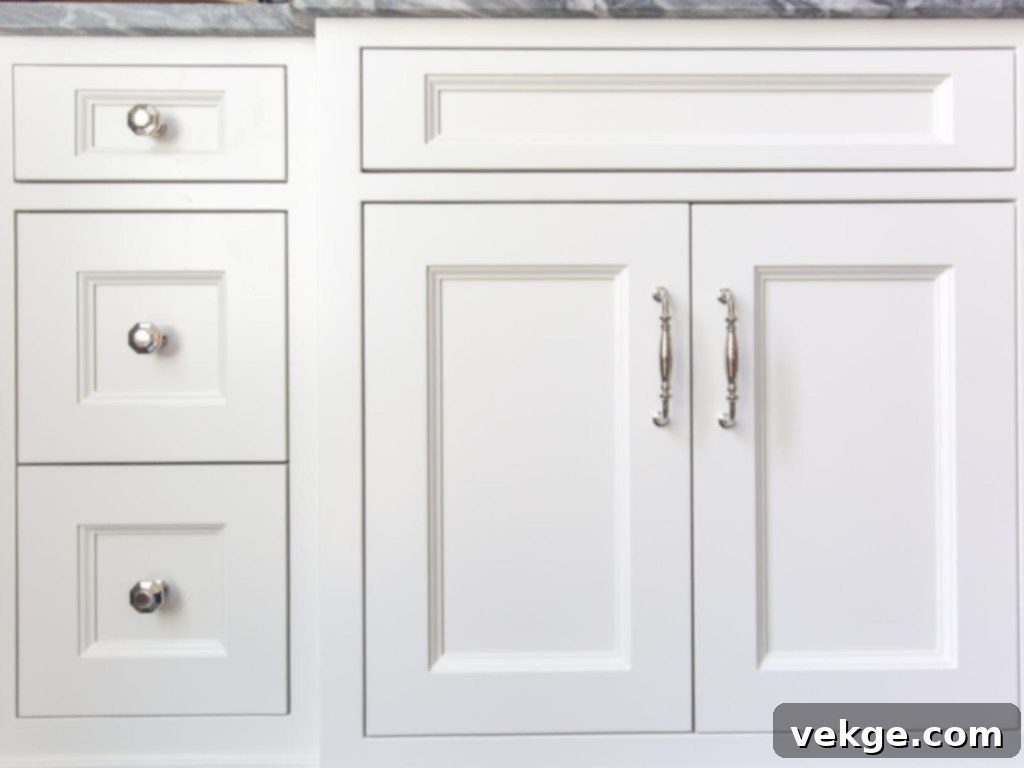
For base cabinet doors, knobs are traditionally installed on the side opposite the hinges. This ensures the door can be opened without obstruction. Before drilling, it’s wise to temporarily hold the knob in place and open the cabinet to confirm the marking is in the most comfortable and functional spot. A common rule of thumb is to place the knob approximately 2.5 to 3 inches vertically from the top (for lower corner) or bottom (for upper corner) edge of the door, and at least 1 inch horizontally from the door’s opening edge. This positioning allows for an easy grip and smooth operation, accommodating various hand sizes.
4. Installation Guide for Wall Cabinet Doors (Knobs)
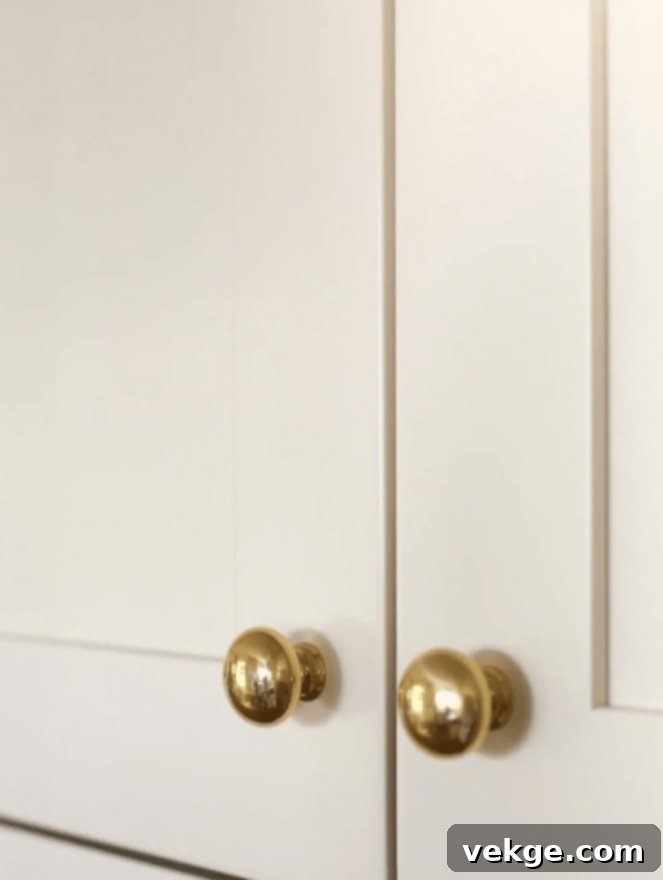
When installing knobs on wall cabinets, the standard placement is in the bottom corner of the door, on the side opposite the hinges. The vertical distance from the bottom edge of the door to the center of the knob should be approximately 2.5 to 3 inches, and the horizontal distance from the opening edge should be a minimum of 1 inch. This placement is ergonomic, allowing for easy access without stretching too much. For very large wall cabinet doors, you might consider placing the knob closer to the center, but always ensure it remains easily reachable without the need for a step stool.
5. Installation Guide for Drawers (Knobs)
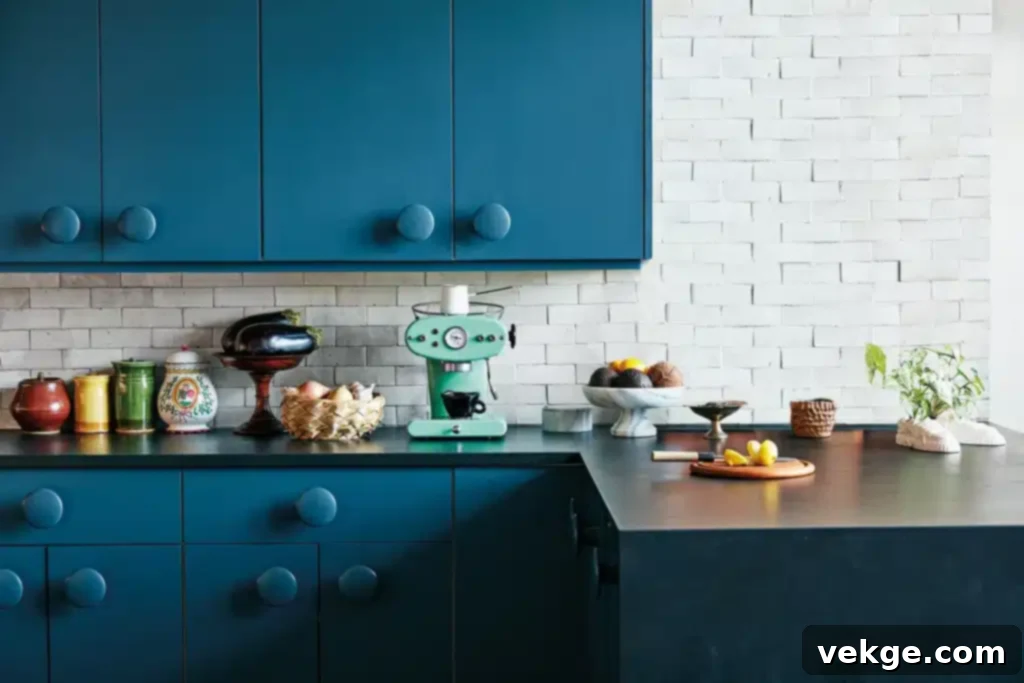
For drawers, knobs are typically centered horizontally on the drawer front. Vertically, you have a few options: you can place the knob in the exact vertical center of the drawer, or slightly higher in the upper one-third section. Another popular method is to place the knob about 2 to 3 inches down from the top edge of the drawer. The chosen vertical placement largely depends on personal preference and the drawer’s design, but the goal is always to make the knob easily accessible for grabbing and opening with minimal effort.
6. Installation Guide for Wall Cabinet Doors (Handles/Pulls)
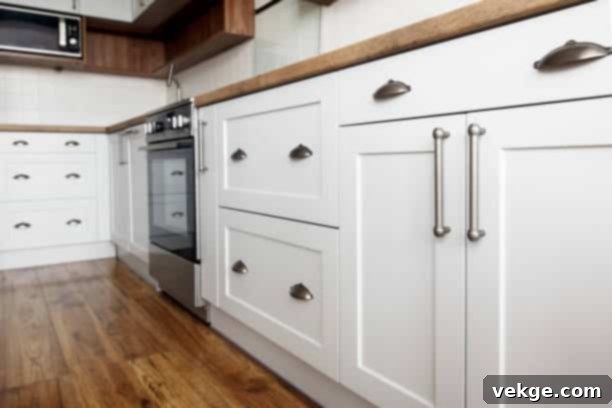
The process for installing handles on wall cabinets is similar to that of knobs, focusing on the side opposite the hinges. Handles typically run vertically on cabinet doors. For wall cabinets, position the handle in the lower corner of the door, ensuring the bottom screw hole is approximately 2.5 to 3 inches from the bottom edge of the door and the nearest edge of the handle is at least 1 inch from the door’s opening edge. Use a level to ensure the handle is perfectly vertical before marking your second drill point. The number of handles required will depend on the width of the cabinet door; generally, one handle per door is sufficient. Once positioned, select a color and design that complements your kitchen’s aesthetic.
7. Installation Guide for Base Cabinet Doors (Handles/Pulls)
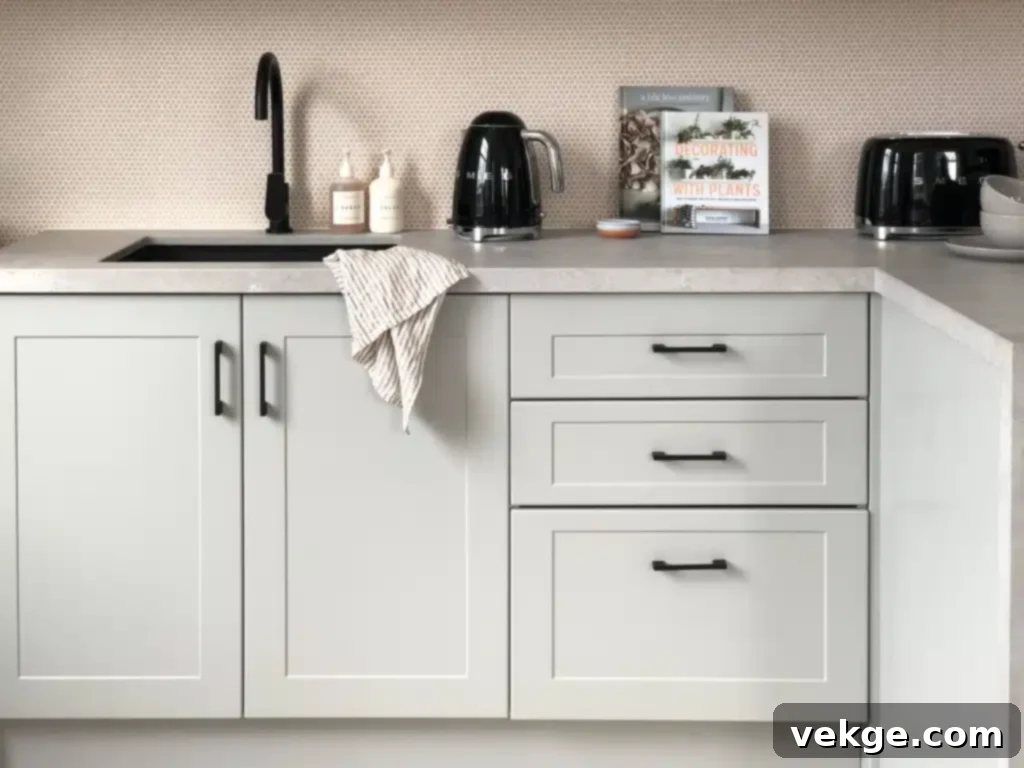
For handles on base cabinet doors, they are typically installed vertically on the side opposite the hinges. Position the handle in the upper corner of the door, with the top screw hole roughly 2.5 to 3 inches from the top edge of the door and the nearest edge of the handle at least 1 inch from the door’s opening edge. Always use a level to ensure perfect vertical alignment before marking both drill points. This ensures an ergonomic reach when opening lower cabinets.
8. Installation Guide for Drawers (Handles/Pulls)
When installing handles on drawers, the goal is typically horizontal centering for both aesthetic balance and ease of use. First, measure the overall length and height of your drawer front. Find the precise midpoint of the drawer by drawing light diagonal lines from corner to corner (or by measuring). This intersection is the exact center. Next, measure the center-to-center length of your handle (the distance between the two screw holes). Divide this length by two. From the center point of the drawer, measure this halved distance outwards on both sides along the horizontal centerline, marking the two points where you will drill. Ensure the handle is also vertically centered on the drawer front. For very wide drawers (over 24 inches), two handles might be more practical and visually appealing. Once the drill points are marked, carefully drill the holes with an appropriate bit and securely fasten the handle using the provided bolts or screws.
Conclusion: The Finishing Touch to Your Dream Kitchen
The kitchen, a bustling hub of activity and warmth, truly comes alive with functional and well-designed elements. Cabinets are undeniably essential for organization, but it is the thoughtful selection and precise placement of cabinet hardware – the knobs and handles – that provide the perfect finishing touch. These seemingly small components play an incredibly significant role, not just in facilitating the easy opening and closing of doors and drawers, but also in dictating the overall style, comfort, and aesthetic outlook of the entire room.
Achieving a harmonious and attractive kitchen goes beyond merely choosing stylish knobs and handles. It demands an understanding of proper placement to ensure visual symmetry and optimal functionality. An improperly installed knob or handle can quickly disrupt the visual flow, making the kitchen feel cluttered and uninviting. Conversely, when hardware is strategically positioned, it elevates the space, creating an environment that is both visually pleasing and highly practical.
For a truly attractive and functional kitchen, dedicate time to accurately measure your drawers and cabinets. Then, with the aid of the right tools and a keen eye for detail, install your chosen knobs or handles at their ideal locations. If you ever feel uncertain about any step of the process, do not hesitate to seek expert advice. Once your hardware is perfectly in place, step back and enjoy a beautifully cohesive, effortlessly accessible, and truly delightful kitchen experience with your family and friends. This small investment in careful planning and execution will undoubtedly pay dividends in daily convenience and long-term satisfaction.
